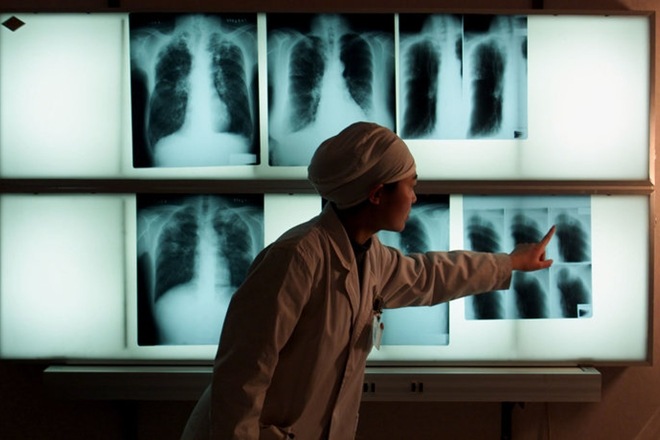Rise of multidrug-resistant tuberculosis threatens to derail the progress made by nations, including India which was among the three countries that accounted for half of over 4 lakh such cases globally in 2015. India is also among the six countries that account for 60 per cent of the total TB cases globally, a study published in The Lancet Respiratory Medicine said. In 2015, there were an estimated 4.8 lakh cases of multidrug-resistant tuberculosis (MDR-TB) globally, with approximately half of these cases being in India, China, and Russia, the study said. “But, migration and travel mean that drug-resistant TB strains have emerged in almost every parts of the world,” it said, adding, “New antibiotics are becoming available for the first time. But without accurate diagnostics, clear treatment guidelines and improved control efforts, their effectiveness could be rapidly lost.”
“The rise of multidrug-resistant and extensively drug-resistant (XDR) tuberculosis threatens to derail decades of progress in controlling the disease,” the new study said. The study comes ahead of World TB day on March 24. Tuberculosis kills more people each year than any other infectious disease, including HIV/AIDS. In 2015, TB was estimated to have killed 1.8 million people and six countries –- India, Indonesia, China, Nigeria, Pakistan and South Africa — account for 60 per cent of the total number of cases of tuberculosis worldwide, the study said.
“Approximately 1 in 5 cases of TB are now resistant to at least one major anti-TB drug and approximately 5 per cent of all cases of TB are classed as MDR (resistant to two essential first-line TB drugs, isoniazid and rifampicin) or XDR (also resistant to fluoroquinolones and second-line injectable drugs),” the study said. It said a small number of repurposed and new medicines have recently become available to treat drug-resistant TB including bedaquiline, delamanid, and linezolid. However, the study warned that without accurate diagnosis, clear prescription on appropriate use and improved control efforts to prevent transmission and well-functioning healthcare systems, the effectiveness of the new drugs could be “rapidly lost”.
Also Watch:
“Tuberculosis exists on an epic scale in India and cases of multidrug-resistant TB are an increasing concern. Access to drugs to treat tuberculosis, including drug resistant TB is a major concern,” co-author of the study, Zarir Udwadia from Hinduja Hospital and Research Center in Mumbai, said. “Despite some small scale programmes for compassionate use of new life-saving drugs, such as bedaquiline and delamanid, there is no widespread access of drugs to fight MDR-TB in India, meaning these drugs remain unavailable to patients who need them most,” Udwadia said.
Udwadia said many patients at risk of transmission or those who need palliative care, live in the community because hospitals are full. In addition to new drugs, there is a need to ensure that patients with incurable diseases are treated with dignity and can afford the care they need, the co-author of the study said. MDR and XDR-TB are associated with high mortality, are a threat to healthcare workers, prohibitively expensive to treat and are therefore a serious public health problem. The study said mortality rate in these cases of tuberculosis is extremely high, around 40 per cent for patients with MDR-TB and 60 per cent for those with XDR-TB. Of the USD 6.3 billion made available in 2014 to respond to the global TB epidemic, about a third of the amount was for MDR-TB (although drug resistant TB forms only 5 per cent of the total caseload), it said.
“Resistance to anti-TB drugs is a global problem that threatens to derail efforts to eradicate the disease. Even when the drugs work, TB is difficult to cure and requires months of treatment with a cocktail of drugs,” lead author of the study, Keertan Dheda of University of Cape Town, said. “When resistance occurs, the treatment can take years and the drugs used have unpleasant and sometimes serious side effects. Cure rates for drug resistant TB are poor and people can remain infectious and at risk of spreading the disease,” Dheda said.
Also Watch:
Improved diagnostic tests are on the horizon, but there is a need to increase accuracy, use those for active case finding and eventually make those available in low-income countries so as to inform treatment decisions and preserve the efficacy of any new antibiotic drugs for TB, the lead author of the study said. TB is caused by a Mycobacterium tuberculosis and is treated with a combination of antibiotics. Extensive overuse and abuse of antibiotics worldwide has led to a rise in bacteria that are drug resistant.
Until recently, it was thought that drug-resistant strains of TB were less transmissible, and that MDR and XDR-TB was mainly acquired by individuals as a result of poor compliance to treatment. However, recent studies have challenged this belief and in most regions of the world, drug-resistant TB is now predominantly caused by transmission. An estimated 95.9 per cent of new TB cases are infected with MDR-TB strains due to the drug resistant bacteria spreading from one person to another.

